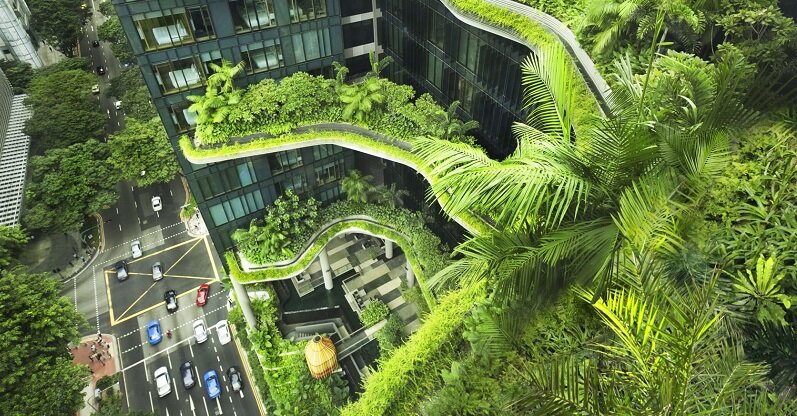Courtesy Parkroyal on Pickering.
Sometimes described as the world’s best manicured concrete jungle, Singapore has for the last six decades been keener on establishing a functional city than protecting its natural environment. Recent changes in both policy and law have seen a significant swing towards environmental protection, primarily the strengthening of Environmental Impact Assessment framework. By Jeremy Torr.
Singapore, November 2020. Hot on the heels of its Natural City announcement earlier this year, Singapore is set to implement a significant change to its environmental impact assessment (EIA) framework.
“We want to transform Singapore into a City in Nature,” said Desmond Lee, National Development Minister. “Indeed, with climate change, more extreme weather conditions, increased urbanisation, we must do more (to protect the environment)," he added. Lee outlined the Singapore government’s commitment to providing citizens with a better quality of life - but not at the expense of flora and fauna.
“We must protect and enhance our natural capital,” he said in a statement. “At the same time, we must house a nation, develop industry, create jobs, provide amenities and safeguard land for future generations.” A tricky balance indeed on an island just 720 km2, and with almost 6 million inhabitants.
The new EIA is aimed at promoting this balance; one that has tilted in favour of condos and factories over previous years. The new EIA process includes three key changes – the introduction of biodiversity impact guidelines, the publishing of development plans on publicly-accessible government websites, and a requirement for planners to consult with – and be certified through – by what it calls ‘nature groups’.
“It is critical we consider the trade-offs.” - Desmond Lee, National Development Minister. Courtesy Singapore government.
“It is critical that we consider the trade-offs we are making with regard to land use, in the spirit of achieving a balance,” added Lee. “We outlined our plans for a City in Nature earlier this year, and recognise our planning processes must be enhanced in tandem to support this vision." Previous iterations of the country’s EIA have been criticised for being ‘carried out in secret when, and if the Government deems them necessary’ with a resulting heavy and negative effect and almost total loss of mangrove, sandy beach and coral reef systems in several development areas. One major development that had significant environmental impact, the Cross Island MRT Line, required parties interested in the completed EIA to make an appointment to read a physical copy of its roughly 1,000-plus pages.
But the new, tougher EIA requirements will help Singapore to move towards a greener city environment in coming years, with more nature integrated into urbanised areas, says the government. This will be done by extending the nature park network, introducing more natural features into the built environment, and strengthening the regulatory framework for new developments.
Some major development EIAs were previously only viewable by appointment. Courtesy ERM.
The new biodiversity impact assessment guidelines, developed by Singapore National Parks Board (NParks), will require all developments to be assessed for environmental impact on biological diversity – not just noise and air pollution as at present, and an update to the Wildlife Act gives NParks the ability to enforcement action against rogue developers who flout the rules. Environmental studies will be a requirement on any development that butts up against an area of ecological significance, such as waterways or nature reserves, and planners from government development agencies will have to complete a course on basic ecology and its links into the EIA process. All good frameworks, although at present it is not clear if this will also be applied to individual commercial developments.
Nonetheless, the move to tighter EIA regulations is seen as a step forward for Singapore, and together with the nature community and government agencies will work to develop a new, greener approach to development. Who knows, it could be the first move in a journey to its City of Nature goal.
"We are seeing how we can strengthen the EIA process, taking on board all the lessons that we picked up in the last few EIAs,” said Lee in an interview shortly after taking office. “We are improving baseline survey methodology, and a (better) understanding of Singapore's perspective and situation,” he said.


